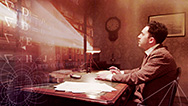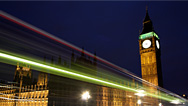A Trip Through Spacetime
- By Susan K. Lewis and Benjamin Wilson
- Posted 09.29.11
- NOVA
Our common sense tells us that space and time are fundamentally separate things. We experience space as a 3-D arena in which our bodies move, and we mark time with ticking clocks and the aging of our bodies. But Albert Einstein's groundbreaking theory of special relativity shows that space and time are actually linked in a 4-D realm called spacetime. Here, explore the logic behind Einstein's astounding insight, and play with a simulation that shows how traveling near the speed of light changes your experience of the flow of time and the fabric of space.
 Launch Interactive
Launch Interactive
Join Albert Einstein on a high-speed cab ride to see why space and time are truly in the eye of the beholder.
Transcript
A Trip Through Spacetime
See how space and time are in the eye of the beholder
1. Einstein understood that the speed of light never changes. All observers, no matter where they are or how fast they're moving, will measure the same speed of light.
2. Einstein realized that if the speed of light never changes, then two people moving at tremendous speeds relative to each other will experience TIME differently.
Imagine a clock made of two mirrors. Whenever light bounces off the bottom mirror, the clock ticks forward one mark.
3. Now, put the clock in an imaginary cab that can travel at 80% the speed of light. To the driver of the cab, here's how time flows:
4. But if you were standing at a crosswalk watching the cab zoom by, you would perceive the passage of time within the cab very differently.
Watching from the crosswalk, you would see the clock within the cab ticking much more slowly. Even though the light beam is traveling at exactly the same speed, from your perspective it is crossing a longer distance, and therefore taking more time to do so.
5. But that doesn't mean that the driver of the cab perceives time passing more quickly at the crosswalk. In fact, from his perspective, it's as if he is standing still and the crosswalk is zooming by him in the other direction. So for the cab driver, time is passing more slowly at the crosswalk.
Physicists call this effect TIME DILATION.
6. Even more amazing, the constant speed of light means that space also changes for observers moving relative to each other.
If the cab driver and you at the crosswalk agree about the speed of light but disagree about measures of time, you must also disagree about measures of length. It's the only way the speed of light—a measure of distance/time—will stay constant. See how...
7. Imagine that the cab driver, as he nears your crosswalk, turns on his headlights. Light travels at about 1 foot/nanosecond. For you at the crosswalk, it takes 10 nanoseconds for the light to travel from one side of the crosswalk to the other. So you calculate that the length of the crosswalk is 10 feet.
Yet the cab driver measures this length as less than 10 feet. How can this be?
8. Remember, the cab driver experiences the passage of time differently. For him, it appears that the light takes fewer than 10 nanoseconds to cross the crosswalk. Therefore, he calculates the length of the crosswalk as fewer than 10 feet.
Physicists call this effect LENGTH CONTRACTION.
9. Just as with time dilation, the situation can be reversed: For you at the crosswalk, the cab zooming by also appears to be contracted in length.
To explore this phenomenon—special relativity in action—climb aboard our imaginary cab. See for yourself how traveling near the speed of light changes the passage of time and the fabric of space.
Take a high-speed cab ride with Einstein
See how, to a stationary observer, your length will contract as the speed of the taxi you're in approaches the speed of light.
Use your webcam to take a photo of yourself, or upload one from your computer, and put it in the taxi.
Move the slider to set the speed of the cab, and see how this changes both space and time.
Credits
Credits
- Producers
- Susan K. Lewis and Benjamin Wilson
- Designer
- Tyler Howe
- Developer
- Daniel Hart
Image Credits
- Intro taxi photo
- © urbancow / iStockphoto
- Einstein
- © Underwood & Underwood/Corbis
- Taxi cab illustration
- © David Shultz / iStockphoto
Related Links
-

The Fabric of the Cosmos
Acclaimed physicist Brian Greene reveals a mind-boggling reality beneath the surface of our everyday world.
-

Inside Einstein's Mind
Retrace the thought experiments that inspired his theory on the nature of reality.
-

Special Relativity in a Nutshell
Brian Greene explains Einstein's notion of the mutability of space and time in a way you can readily understand it.
-

Putting Relativity to the Test
Nearly a century after Einstein published his general theory, experiments continue to confirm its every prediction.
You need the Flash Player plug-in to view this content.

